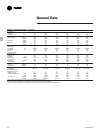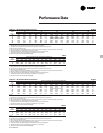
17
RLC-PRC016-EN
Application
Considerations
b. Provide Vertical Clearance
Vertical condenser air discharge must be
unobstructed. While it is difficult to
predict the degree of warm air
circulation, a unit installed as shown on
the left would have its capacity and
efficiency significantly reduced.
Performance data is based on free air
discharge.
c. Provide Lateral Clearance
The condenser coil inlet must not be
obstructed. A unit installed closer than
the minimum recommended distance to
a wall or other vertical riser may
experience a combination coil starvation
and warm air recirculation, resulting in
unit capacity and efficiency reductions.
Once again, the Adaptive Control
™
microprocessor will allow the chiller to
stay on line, producing the maximum
available capacity, even at less than
recommended lateral clearances.
The recommended lateral clearances are
depicted in the dimensional data section.
These are estimates and should be
reviewed with the local Trane sales
engineer at the jobsite.
d. Provide Sufficient Unit-to-Unit
Clearance
Units should be separated from each
other by a sufficient distance to prevent
warm air recirculation or coil starvation.
The air-cooled Series R
™
chiller has the
lowest recommended unit-to-unit
clearance in the industry, eight feet.
Consult the local Trane sales engineer for
applications concerning close spacing
and restricted airflows.
e. Walled Enclosure Installations
When the unit is placed in an enclosure
or small depression, the top of the fans
should be no lower than the top of the
enclosure or depression. If they are,
consideration should be given to ducting
the top of the unit. Ducting individual
fans, however, is not recommended.
Such applications should always be
reviewed with the local Trane sales
engineer.


















